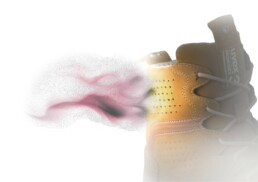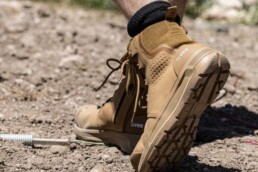Heat stress is a hazard in many workplaces and those that are exposed to temperatures above 30°C and or high humidity need to have a heat stress management plan. Safety footwear is often required to reduce the risks of traumatic injuries. However, footwear design can have a significant impact on physiological strain and can increase risks of heat stress due to the weight, rigidity, and lack of breathability of the footwear. Safety footwear is often marketed to have breathable components. However, minimal evidence is available to understand if this footwear is more breathable and if workers can detect breathability differences while working. The study outlined below investigated how a style of safety footwear designed to be more breathable compares to existing safety footwear in laboratory tests and if workers can perceive a difference in hot work climates.
Study Methods: Breathability of a style (uvex 3 x-flow zip, UVEX Arbeitsschutz GmbH, Furth Germany) designed to have improved breathability through material selection, layer minimisation and manufacturing processes and a comparable market leading 150mm/6′ zip side safety footwear style (control) were analysed in a climate chamber (KMF 240, Binder GmbH) with a sweating foot mannequin. Heat index combining both relative humidity and temperature and absolute humidity were assessed at 23°C and 50% relative humidity. Eight male and two female workers in Queensland, Australia completed a digital 10-point analogue scale questionnaire on footwear comfort and breathability on their existing safety footwear and then the uvex x-flow footwear after a 4-week wear trial. End points were labelled as “most breathable imaginable” and “not breathable at all”. Statistical significance was assessed with a paired sample T-Test.

The results of the study showed that the uvex 3 x-flow zip was 15% and 11% better than the control footwear for the climate index and absolute humidity respectively (Climate index, control: 39.91 g/kg vs. x-flow: 33.78g/kg; Absolute humidity, control: 22.6g/kg vs. x-flow: 20.1g/kg). The mean daily maximum temperature from the workers locations was 25.3°C (23.9 – 27.7°C) and mean maximum temperature was 29.2°C (28.1 – 31.9°C) during the trial period. Eight of the ten workers rated the x-flow footwear to be more breathable than their existing footwear with a mean improvement of 38% (Existing footwear: 5.1 (SD 2.3) vs. x-flow: 7.0 (SD 2.2), p<0.05). The x-flow footwear was rated as being 12% more comfortable (Existing footwear: 7.0 (SD 1.8) vs. x-flow: 7.9 (SD 2.0), p=0.36), 13% less fatiguing (Existing footwear: 6.0 (SD 2.4) vs. x-flow: 6.8 (SD 2.3), p=0.29) and 23% lighter (Existing footwear: 6.2 (SD 2.4) vs. x-flow: 7.6 (SD 2.8), p=0.11) than their existing footwear however these variables did not reach statistical significance.
Conclusions: A wholistic approach to the design of safety footwear breathability can improve laboratory measured breathability that is appreciable to workers. A 15% improvement in laboratory measured breathability resulted in a considerably larger perceived breathability difference of 38% compared to their existing footwear when worn in a hot working environment. Compared to their existing footwear the improved breathability of safety footwear can make a significant difference for workers in hot environments.

Talk to uvex footwear specialist for more information on uvex safety footwear. Learn more about uvex footwear technologies.
Based on a white paper by Dr Caleb Wegener PhD (Biomechanics), B App Sc (Pod) Hons.
Head of Product Management, Footwear, Uvex Safety I Honorary Research Associate, Faculty of Health Sciences, The University of Sydney